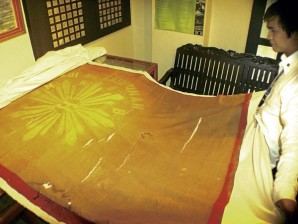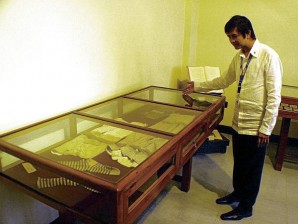Museum keeps KKK flag

CURATOR Alvin Zamora of the Rizaliana Museum unfurls the KKK flag that has been with the University of Southern Philippines Foundation since 1951. The flag has splotches of blood and is the only one existing in the country.
CEBU CITY—The celebration of Independence Day on Tuesday took a deeper meaning than a no-work, no-class holiday for Arnel Garcia, a sophomore accounting student of the University of Southern Philippines Foundation (USPF) in Cebu City.
Garcia has learned that his school is the home of the 116-year-old flag of the KKK, or the Kataas-taasan Kagalang-galangang Katipunan ng mga Anak ng Bayan (Highest and Most Honorable Society of the Sons of the Nation), the armed revolutionary movement of Filipinos against Spanish and American colonial rule.
“It is a great honor that the KKK flag is in our university. It definitely has an effect on our celebration of Independence Day because it is a symbol of what Filipinos are and it will help inculcate to the minds of the students the essence of freedom,” he said.
Rizaliana Museum
The KKK flag is being preserved at the privately owned Rizaliana Museum inside the USPF Mabini campus in downtown Cebu City.
Article continues after this advertisementIt has traces of blood, which, according to Alvin Zamora, the curator, indicates that it fluttered while the Katipuneros battled the Spaniards.
Article continues after this advertisement“The flag is a witness to the physical struggles of the Katipuneros,” Zamora said.
For about 60 years, the fading cloth of history has been kept at USPF. On May 25, it was publicly displayed for the first time in recent years during the Gabii sa Kabilin (GSK or Night of Heritage), in which the USPF Museum was among the 22 featured museums and heritage sites.
Started in 2007, the GSK is a yearly undertaking of Ramon Aboitiz Foundation Inc. to encourage the public to visit museums and regard these as venues for cultural understanding.

A COLLECTION of undergarments owned by Dr. Jose Rizal is displayed at the private museum inside the University of Southern Philippines Foundation-Mabini campus in downtown Cebu City. PHOTOS BY EDISON DELOS ANGELES
According to Zamora, the one-night public exposure of the flag has achieved its objective of making the Cebuanos aware that it exists and is not just a metaphoric symbol of the Katipuneros’ struggle.
The people should be made aware of the KKK flag since it is the only one existing in the country, he said.
Traces of blood
Labeled as the “Original KKK Flag-1896,” the historical piece was mentioned in a book authored by Adrian Cristobal, titled “The Tragedy of the Revolution.” The book is about the life and death of Andres Bonifacio, founder of the Katipunan and father of the Philippine revolution.
According to Cristobal, the KKK flag was woven during the Philippine revolution against the Spanish regime and contains all the elements of the different Katipunan flags.
Brownish in color, it bears an ancient Tagalog script for K ( ) at the center of a multirayed sun. The words “Labi ng Katipunan” are printed above the sun.
Also on the flag are the letters “KKK MANB,” an abbreviation of the full name of the Katipunan.
The flag was given to the family of the national hero, Dr. Jose Rizal, after he was executed in 1896, Zamora said.
Trinidad’s donations
Rizal was considered an honorary member of the KKK. Many of his personal belongings were given to his sisters, Lucia and Trinidad.
When Trinidad went to Cebu on Feb. 11, 1951, she gave the flag and some items of Rizal’s memorabilia to her grandniece and Lucia’s granddaughter, Concepcion Herbosa. At that time, Herbosa was married to Escolastico Duterte, the second vice president of USPF and nephew of the school’s founders, Beatriz Duterte Jereza and her husband, Augustin Jereza.
It was not surprising that when the USPF owners decided to put up a museum on its campus in Barangay Mabini in the 1970s, they named it after the national hero. In fact, the Rizaliana Museum has the richest collection of the national hero’s memorabilia in the country.
Another museum branch was put up on the USPF campus in Barangay Lahug, also in Cebu City.
The Rizaliana has the original letters of Josephine Bracken to Rizal and the collection of 1899 and 1900 editions of his classic books, “Noli Me Tangere” and “El Filibusterismo.” It also showcases Rizal’s checkered winter coat, pants, overcoat and other personal belongings.
Public display
Some of the items have been given for safekeeping to the National Museum in Manila. These include the lamp used by Rizal when he wrote his last poem, “Mi Ultimo Adios,” inside his Fort Santiago cell.
In the 1990s, the framed KKK flag was displayed at the Rizaliana Museum in USPF-Lahug. But museum officials took it down in 1997 after Wendy Smith of the National Museum of Australia observed that it was not a proper way of preserving the flag. Smith advised them to preserve the flag in a glass casing.
When Zamora was appointed curator in October last year, he suggested to Lourdes Jereza, museum director and USPF vice president for external affairs, to highlight the flag during the GSK on May 25 so it could be used as “a tool for instruction and encourage patriotism among Cebuanos.”
“We have to feature this (flag) because we are the only institution that has this flag in the Philippines and has considered it one of the best features of the museum,” he said.
The recommendation was approved and the flag had a one-night only public display.
Zamora said visitors could still see the flag upon request. They must have prior booking and their number must be at least 15.
The museum charges P25 per adult and P15 per child. A USPF student gets in for free.
According to Dean Charles Baguio of the USPF College of Arts and Sciences, the KKK flag brings students closer to the time when their ancestors heroically stood for the cause of freedom.
“The flag showcases the bravery and determination of our heroes and because there is blood in that flag, it reminds the students that Filipinos are willing to fight for what they aspire for. It may be a flag but it shows who Filipinos really are,” he said.